Rail Analysis: Please share with us your experience in this industry so far. What have been some of the major achievements and challenges you have faced till now?
Shri P Uday Kumar Reddy: 1986-batch officer of the Indian Railways Service of Mechanical Engineers (IRSME), assumed the role of General Manager of Metro Railway, Kolkata, in March 2023. Prior to this, he served as the Additional General Manager of South-Central Railway in Secunderabad. His extensive career includes significant positions such as Chairman of Railway Recruitment Boards in Secunderabad and Bangalore, Chief Administrative Officer at Integral Coach Factory (ICF) in Chennai, Chief Works Engineer in Southern Railway, and Divisional Railway Manager in Tiruchirapalli. He has also undergone various leadership and strategic management training programs both in India and abroad.
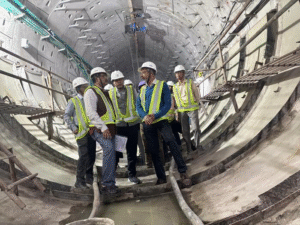
Under his leadership, Metro Railway, Kolkata, has seen notable advancements. In August 2024, he highlighted the metro’s achievements, including carrying 19.25 crore passengers between April 2023 and March 2024, an 8.8% increase from the previous year. Financially, the metro earned ₹119.95 crore during the same period, marking a 15.41% rise. He also emphasized the growing adoption of digital payment methods among commuters. He has been instrumental in guiding the entire team for completion of connectivity between Esplanade and Howrah Maidan Metro Stations.
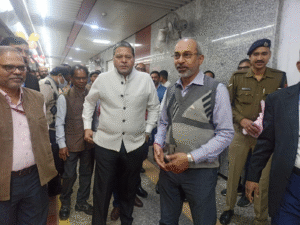
“The stretch was inaugurated by Honourable Prime Minister Mr. Narendra Modi on 6 th March 2024. Also, he ensured completion of construction of the most challenging phase of the East-West Metro corridor at Bow Bazar.”
Entire length of the project is now connected and is awaiting inauguration very soon. His continuous monitoring and support is enhancing the advancement of Noapara-Bimanbandar metro corridor, Garia-Airport Metro Corridor and Joka-Esplanade Metro Corridor also, by sorting out hurdles in positive note. Beyond infrastructure, Shri Reddy has focused on staff well-being. In February 2025, he inaugurated a stress management camp for metro staff at Metro Rail Bhavan, where 116 employees participated in wellness activities like yoga and Sudarshan Kriya. Through his multifaceted approach, Shri P. Uday Kumar Reddy continues to drive the growth and modernization of Kolkata’s metro system, ensuring it meets the evolving needs of the city’s commuters.
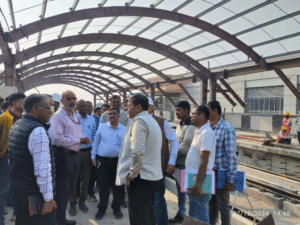
Rail Analysis: Kolkata Metro has long held the distinction of being India’s first metro system. Could you share how the organisation’s current vision is shaping the future of urban transit in Kolkata?
Shri P Uday Kumar Reddy: Kolkata Metro, India’s pioneering metro system inaugurated in 1984, is undergoing a transformative expansion and modernization to meet the evolving needs of urban transit. With a current network spanning approximately 60 km, the metro aims to extend to 90 km by 2025 and over 130 km by 2027, connecting more areas across Kolkata and Howrah.
Key Developments Shaping the Future of Kolkata Metro:
- Expansion of Network and Infrastructure:
- The metro is set to add 61 km of tracks by 2026, including extensions like the Joka-Esplanade and New Garia-Airport corridors.
- Plans are underway to connect the airport with New Garia and Noapara by December 2025, facilitating comprehensive city coverage.
- Integration of Advanced Technologies:
- The East-West Corridor is preparing for unmanned operations, pending regulatory approvals, aiming to enhance efficiency and safety.
- The introduction of Battery Energy Storage Systems (BESS) at key substations will improve energy resilience and support electric mobility.
- Sustainability Initiatives:
- Kolkata Metro is enhancing its solar power capacity, with installations across various stations and depots, contributing to the Indian Railways’ goal of becoming a Net Zero carbon emitter by 2030.
- The replacement of steel third rails with aluminium alternatives on the Blue Line is underway, aiming to reduce energy consumption and operational costs.
- Passenger-Centric Enhancements:
- The metro is procuring 47 new rakes, including international and domestic models, to accommodate the anticipated increase in ridership, projected to reach 18 lacs daily passengers by 2025 from its present average daily ridership of 6 lacs.
- Efforts are being made to improve station facilities and streamline operations, ensuring a comfortable and efficient commuting experience.
These initiatives reflect Kolkata Metro commitment to evolving as a modern, sustainable, and efficient urban transit system, aligning with global trends and addressing the growing mobility needs of the city.
Rail Analysis: What are the key milestones achieved in completing Kolkata’s East-West Metro Corridor, and how will its full operation transform the city’s commuting experience?
Shri P Uday Kumar Reddy: The East-West Metro Corridor in Kolkata, also known as the Green Line, is a transformative project that aims to revolutionize urban commuting in the city. Here’s an overview of its key milestones and the anticipated impact on Kolkata’s transportation landscape:
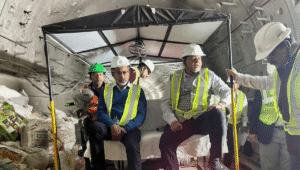
Key Milestones:
- Inauguration of Phase I (Salt Lake Sector V to Salt Lake Stadium): In February 2020, the first phase of the Green Line was inaugurated, marking a significant step in expanding Kolkata’s metro network.
- Completion of Underground Stretches: The underground sections extending to Phoolbagan were completed in October 2020, followed by the extension to Sealdah in July 2022.
- Underwater Tunnel Under the Hooghly River: A notable engineering feat, the 10.8 km tunnel with underwater tunnelling beneath the Hooghly River was completed in 2021, with operations commencing in March 2024.
- India’s deepest underground metro station: Construction of India’s deepest underground metro station at Howrah, excavating through alluvial soil of Gangetic plane, itself was a milestone.
- Trial Runs on Sealdah–Esplanade Stretch: In January 2025, successful trial runs were conducted on the 2.63 km stretch between Sealdah and Esplanade, bringing the full corridor closer to completion.
- Full Operational Status: The entire East-West Metro Corridor is expected to be fully operational by June 2025, significantly enhancing connectivity across the city.
Transformative Impact on Commuting:
- Reduced Travel Time: The Green Line will cut down travel time between Howrah and Sealdah from approximately 90 minutes by road to just 11 minutes by metro.
- Enhanced Connectivity: The corridor will seamlessly connect key areas such as Salt Lake, Dum Dum, Sealdah, and Howrah, facilitating efficient travel across the city.
- Advanced Signalling Technology: The implementation of the Communications-Based Train Control (CBTC) system will enable Automatic Train Operation (ATO), enhancing safety and operational efficiency.
- Environmental Benefits: By reducing reliance on private vehicles, the metro will contribute to lower traffic congestion and decreased carbon emissions, promoting a cleaner urban environment.
- Economic Growth: Improved accessibility is expected to stimulate economic activities along the corridor, fostering development in previously underserved areas.
Future Prospects:
- Increased Ridership: With the anticipated reduction in travel time and enhanced connectivity, the metro is expected to attract a significant number of daily commuters, alleviating pressure on the city’s road transport system.
- Urban Development: The metro corridor is likely to spur transit-oriented development, leading to the growth of commercial and residential spaces along its route.
- Technological Advancements: The integration of advanced technologies in metro operations will set a benchmark for future urban transit projects in India.
The completion of the East-West Metro Corridor represents a significant milestone in Kolkata’s journey towards modernizing its public transportation infrastructure. By enhancing connectivity, reducing travel time, and promoting sustainable urban development, the metro is poised to transform the city’s commuting experience.
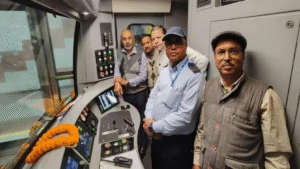
Rail Analysis: With the recent induction of Dalian rakes on the Blue Line, how is Kolkata Metro enhancing service capacity and commuter experience through these additions?
Shri P Uday Kumar Reddy: The recent induction of Dalian rakes into Kolkata Metro’s Blue Line marks a significant enhancement in both service capacity and commuter experience. These modern trains are designed to address the growing demand for efficient urban transit while prioritizing passenger comfort and safety.
Key Features of Dalian Rakes:
- Increased Seating Capacity: The new rakes offer more seating options, including additional spaces designated for senior citizens and differently abled passengers, ensuring a more comfortable journey for all commuters.
- Enhanced Accessibility: Equipped with 100 mm wider doors compared to existing AC rakes, these trains facilitate smoother and quicker boarding and alighting, especially during peak hours.
- Improved Air Conditioning and Noise Reduction: The rakes feature high-capacity air conditioning systems and advanced noise reduction technology, providing a more pleasant and quieter ride.
- Modern Passenger Amenities: Inside the coaches, passengers will find full CCTV coverage, modular and wider vestibules, aesthetically designed interiors, uniform illumination, multilingual display boards, and wheelchair parking facilities.
- Enhanced Safety Features: Safety is a top priority with the inclusion of disc brake systems, controlled-discharge fire extinguishers, wider evacuation doors, and anti-skid rubber flooring on evacuation ramps.
Impact on Commuter Experience:
- Reduced Congestion: The introduction of additional rakes increases train frequency and capacity, alleviating overcrowding during peak travel times.
- Faster and More Comfortable Journeys: With improved air conditioning and noise reduction, passengers can expect a more comfortable and efficient commute.
- Enhanced Safety and Accessibility: The new safety features and accessibility improvements ensure a safer and more inclusive travel experience for all passengers. In summary, the integration of Dalian rakes into the Blue Line is a strategic move by Kolkata Metro to modernize its fleet, enhance operational efficiency, and provide a superior commuting experience for passengers.
Rail Analysis: As the first metro in India to implement a Battery Energy Storage System at the Central substation, what benefits does Kolkata Metro anticipate in terms of energy reliability and efficiency?
Shri P Uday Kumar Reddy: Kolkata Metro has introduced a pioneering Battery Energy Storage System (BESS) at its Central substation, marking a significant advancement in India’s metro infrastructure. This initiative aims to enhance energy reliability and operational efficiency, setting a benchmark for other metro systems across the country.
- Key Benefits of the Battery Energy Storage System: Emergency Power Supply in Grid Failures. In the event of a power outage, the BESS can provide immediate backup, enabling trains to move at speeds up to 30 km/h to the nearest station. This capability ensures that passengers are not stranded in tunnels or viaducts, significantly improving safety during emergencies.
- Cost Savings and Energy Efficiency: The 4 MW BESS, utilizing 6.4 MWh Lithium Iron Phosphate (LFP) batteries, allows Kolkata Metro to store energy during off-peak hours and utilize it during peak demand periods. This strategy will save in peak hour demand charges and will also save through power factor improvement over its lifespan.

- Support for Tunnel and Platform Ventilation: In case of emergencies, the BESS can power essential systems such as tunnel ventilation and platform exhaust, ensuring continued safety and air quality in critical areas.
- Eco-Friendly and Sustainable Operations: The LFP batteries used are part of the National Programme on Advanced Chemistry Cell (ACC) Battery Storage, emphasizing reduced carbon footprint, improved energy efficiency, and enhanced safety compared to traditional battery technologies.
Future Expansion Plans:
Kolkata Metro plans to expand its BESS infrastructure by adding with Traction Energy Storage System (TESS) capabilities in new Blue Line substations. These additions will enable the storage of energy generated during regenerative braking by the trains, further enhancing energy efficiency and reducing operational costs.
“By integrating the BESS, Kolkata Metro not only improves its operational resilience and cost-effectiveness but also sets a precedent for sustainable and reliable urban transit solutions in India.”
Rail Analysis: Given the advanced features of the CBTC system, such as automatic train protection and operation, how Kolkata Metro ensuring the safety and reliability of these systems before full-scale deployment?
Shri P Uday Kumar Reddy: Kolkata Metro is meticulously ensuring the safety and reliability of its Communication-Based Train Control (CBTC) system through a comprehensive, multi-phase testing and certification process. This approach aims to guarantee the system’s robustness before its full-scale deployment across the East-West Metro Corridor.
Rigorous Testing and Trial Runs:
- Extensive Trials on Green Line: Prior to commissioning rakes will have to undergo extensive trials. These trials are essential for securing third-party certification for safe operation.
- Software Validation: To integrate the CBTC system across the entire corridor a block is required to validate and fine-tune the newly installed software. This period allows for adjustments and ensures the system’s reliability.
- Upgraded Rakes for Testing: Two rakes from the existing fleet have been upgraded with CBTC technology to conduct signalling tests. These tests are part of the ongoing efforts to ensure the system’s functionality and safety.
Safety Assurance and Certification:
- Independent Safety Assessor (ISA) Evaluation: Once the system’s safety and reliability are confirmed, the entire setup undergoes an inspection by an ISA for final approval.Following this, the Chief Railway Safety Commissioner conducts a statutory inspection before granting permission for commercial use.
- Emergency Response Features: The CBTC system includes features such as automatic train protection to prevent collisions, speeding, and red-light violations. In emergencies, a single button press at the control centre can stop all trains simultaneously, enhancing overall safety.
Scheduled Testing and Service Adjustments:
- Sunday Service Suspensions: To facilitate thorough testing of the CBTC system, Kolkata Metro has suspended services on the East-West Corridor every Sunday since March 23, 2025. This schedule allows uninterrupted time for system assessments and adjustments. Through these meticulous testing phases and safety protocols, Kolkata Metro is committed to delivering a reliable and secure CBTC system, ensuring a safe and efficient commuting experience for passengers.
Rail Analysis: Anything else you would like to share with our readers?
Shri P Uday Kumar Reddy: Kolkata is proud owner of India’s first underground metro corridor and now we have India’s first under water metro corridor also. India’s deepest shaft is in Strand Road of Green Line (East-West) Metro Project, Howrah Metro Station of Green Line is India’s deepest metro station and Airport Metro Station of Orange Line contains India’s largest metro station with yard facility.
Images Credit: KMRCL
This Interview is a part of our latest Magazine: Subscribe to our Magazine Today!
![]() Timely insights, straight to your WhatsApp—stay updated with ease!
Timely insights, straight to your WhatsApp—stay updated with ease!
![]() Stay connected to the rail industry—timely news, straight to Telegram!
Stay connected to the rail industry—timely news, straight to Telegram!


